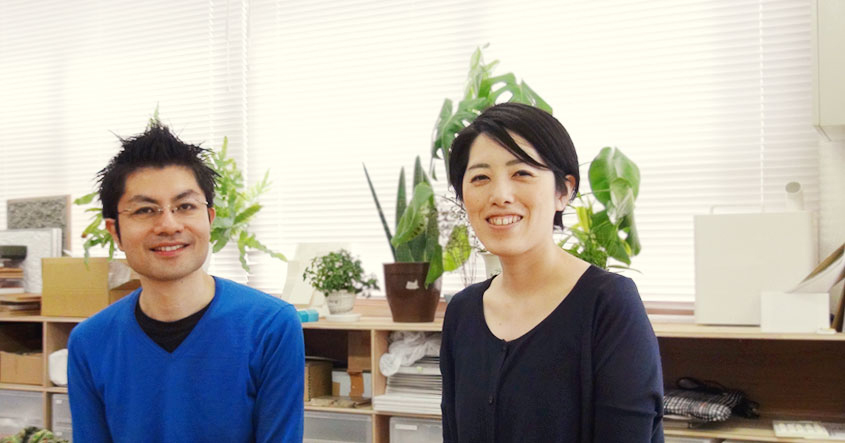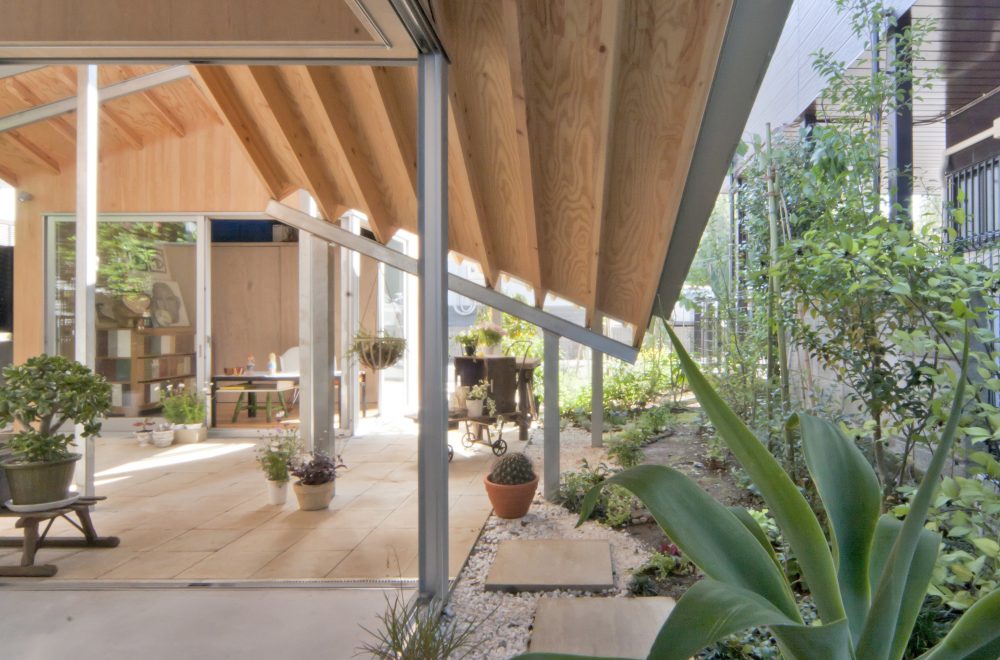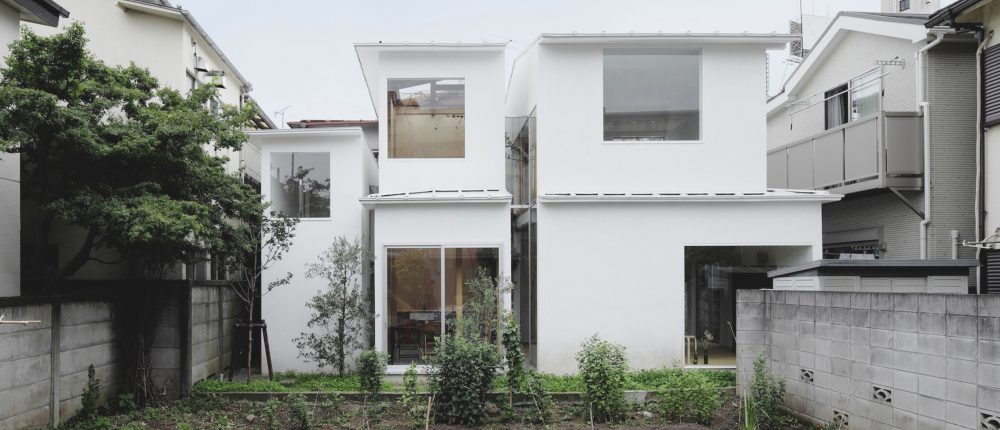
Window and Sharing (First Half)
24 May 2013
- Keywords
- Architecture
- Conversations
- Interviews
Interviewed are now widely noted architects, Yuri Naruse and Jun Inokuma, who are well known for their project on the theme of “sharing.” The talk is centered on the role and enchantment as well as a challenge of the window creating a feel of sharing.
Window sides make the shared space comfortable
Inokuma: I think that in the past, there were design projects similar to the share house. For instance, Saishunnkan Dormitory designed by Mr. Imojima seems to be a typical example. In this dormitory, there is a huge living space, in the center, which is surrounded by private rooms on both sides. This floor plan proves it to be the forerunner of the share house. We, then architectural students, were excited to look at it and exclaimed that it was really great and how radical it was. Rent house developers, however, did not follow that pattern of houses.
But, ten or fifteen years later, the same pattern of houses yet incorporating management operation of house emerged from a non-building operator side and was named “share house.” To provide a space serving as a pause seems to have existed from Mr. Imojima’ dormitory work. He used the word “to share” by probably knowing that it would convey a proper feel of the space to people of the same sector. I thought that the word “to share” was a wonderful word to convey to non-building related people a sense of space between public and private activities or space between a person and another person.
In addition, semi-public spaces, cafés or offices embedded in an urban area also have a new life style which is better phrased with the word “to share.” It is interesting how new possibilities should be embarked on with arrangement of those spaces.
If an architect fails to properly provide a common use space, few people do not walk up to enjoy it. Instead, they will mostly spend time at their private room. When an architect decide offhand the function of a space, the occupants are likely to take a private room a space where an occupant stays himself and a public space where all occupants gather; however, contrary situations seems to be also meaningful and comfortable. For instance, in a large living room, one occupant is reading a book alone, some come together to take tea or a couple of occupants in some groups are chattering, while one occupant is sitting alone without joining any group. It is hard to expect for all the occupants to come together, unless any event takes place. In the course of design, a public space is frequently thought implicitly to be a place where all gather. I always try not to be driven by such an implicit connotation. In design, a window has particular meaning to me. The space along the window is likely to become a quiet sitting place for a single person. If there is a chair on the window side, that place is likely to become a small space independent of the surroundings. In such an image, the sitting person impliedly feels as if he spent time together with the outside world over the window. In such a situation, I frequently think that the window’s power is great. For instance, on a large-scaled innovation project, there is a case where a common use space has to be provided in such a place as where a window cannot be located. In such a case, it is considerably difficult to locate a sitting place for a single person. In the case of a new construction project, I usually prearrange in design the properly emphasized window side. Then, by simply putting furniture there, a relaxing atmosphere can be formed for a sitting space for a single person. In the case of a café, a counter is sometimes fixed along a window, it would be very usable for a single person. It produces a merit as it is alongside the window. If a person is sitting on a window side, looking at an outside scene, it may be a sign saying “let me alone.” In this sense, I put an emphasis on keeping such approach to the window. In an attempt to prearrange the window side, I usually pay my attention to the location and size of a window.
It is also important how the indoor space is seen from a town street
Naruse: As for a space shared among inhabitants, for instance, as in the case of a share house, if the space is internally shared by them, but closed from outside, another view seems to emerge on interconnection with the outside, apart from the inside intimacy. Depending on a case, it will become a place people feel strange when viewed from outside. Such intimacy relation is sometimes too much exhausted to be refreshed. In this connection, it is, in my opinion, an important element of design how to interconnect the outside in order for the sharing space to be continued.
For such occasion, I think that the window is a key element, since it is very important whether the window induces people to inside or whether the inside atmosphere is overflowing to outside. It may be feasible for management to exert themselves for smooth communication to invite outside people, even though the building itself is not so enchanting; however, it is more important where the window is located, how widely it is opened and how deeply the inside can be seen so that people may freely frequent the inside. For this reason, the window is very important and serves as a vital key.
Inokuma: I and my colleagues always take a view that the window forms a considerably large element in developing town scenery. This is simply true with window shapes and sizes. As Ms. Naruse explained, what can be seen inside the window is also important. If it is provided amateurishly, the result would be exposure of privacy. If it is provided in a professional manner, the dinner time atmosphere of family circle is faintly emanated outside, suggesting an image of a good town. To develop a lively town space, it is very important how built-up formation within the premises is reflected in the townscape. If a hundred of substantially windowless houses are lined up, that scene is miserable as it were a dead town. To provide something to link them is considered to be important for the town to be lively. In addition, the façade of a house is taken into account. In an urban area, the building code demands that houses should be kept to certain max. height, eventually to draw same height of skyline. Variation of windows will contribute to accentuating of the townscape. In this sense, if we can design how a window is opened and how the windows vary from those provided in next house or vary when ten houses are lined up, we can contribute, in our opinion, to lively or vitalized townscape. In this connection, the windows provided in the walls and their internal use by the inhabitants has to be properly adjusted in design.
As regards the adjustment of the window view from outside and inside use, the inside should be blindfolded when such a large window is provided as will expose it to outside view or the inside space should be arranged so that the inhabitants can know the exposure to outside by properly arranging the composition of the space. The space widely exposed to outside view should be arranged so that inhabitant’ back postures not to be exposed to outside view and that inhabitants behave with their back exposed to outside view without knowing such outside view. The window size should be such as to allow the inhabitants to behave with consciousness of being viewed from outside or to be impliedly agreeable to the inhabitants or outside people. If such size selection fails, the curtain will be closed and confined. In this context, spatial expanse of a widowed room bears considerable importance. Not to speak of window size itself, the depth of a room or ceiling height is likely to have important bearing. If a room is deep enough, a large window seems to be allowed in most cases.
I love fully openable window when I want to do so
Inokuma: In addition to the visual effects, wind running through the window adds to enhance comfortableness in habitation, to which fact I always pay my attention. Since I heard from a professor in my university days that good housing would make its occupants fresh with wind running through it, that explanation remained unfaded in my mind. When we cherish an outdoor scene out of a window, it will fix the scene. A ventilation opening is usually taken minimal as the exhaust air runs toward abutting house’s wall. On our part, we do not pay much attention to such a thing. However it is senseless, we usually try to keep it large. When a window serves as a contrivance to link the inside to outside, I am fond of opening it to let in outdoor fresh air. In the case of tall sliding doors, an occupant freely goes out or come back, namely, he/she likes the scene where indoor/outdoor air fuses as if they were in a single mass. I like a feeling that I am inclined to fully open it when I am cheerful as an instinct or a physical pleasure.
Naruse: Now I am engaged in the design/construction supervision for a house having a courtyard. This house also has a large opening facing the courtyard. Though I admit that if the courtyard is focused by the family, it would look smart for a transparent glass pane to be fixed; however, I insist on the opening of glazed-in doors provided in the opening. Wind and people walk from ridge to ridge as if all items were connected.
For instance, if it is assumed that a cherry tree is in full blossom, a family member sitting on the best position to look at it would be capable of feel scent and flower season. Though I was not conscious of such coincidence of the situations, I now feel happy.
Inokuma: Out of house building components, what an owner can adjust would be a window which can be the largest architectural component. Though other components, such as columns, walls, ceilings and floors, cannot be changed without any alteration work, some windows are larger than any large item of furniture and can be changed by the owner. Instead of being closed by panel work, the opening had better be utilized vividly. In other words, such large opening or movable part would attract people and give the inhabitant a choice to alter a house according to his own choice. The window can be expected to give rise to such a chance. It would be most understandable example to fully open a window when the inhabitant is inclined to do so. We are looking at the window from such a viewpoint or we wish it were such a utility work.
Desirous of this type of “Window”
Inokuma: It would be ideal for a window to open by itself. It would be delightful if a window section finished in the same way as for the exterior wall easily open out en block; however, it involves fire prevention scheme and surface finishing varying from house to house. It seems to be not an easy task for a manufacturer of mass production. One ideal, practical product may be a window section finished flush in the same way as for the exterior wall, made openable.
Naruse: Personally I am found of folding partitions/doors, though it may be a commonplace topic. It is frequently flung open, lighter than sliding doors, but has larger frames.
Inokuma: Certainly. We wish there were delicate folding partitions.
Naruse: Sometimes, when we are in a café restaurant, someone happen to say that it would be better if there is a series of folding screens. The pros and cons of the folding system are discussed from various angles and the people finally give up the use for the reason that it would hamper their walking around when it is closed. I am always thinking that though it may be difficult to make the folding doors more delicate, if it is made possible, the inside and outside the window are made to give a feel of continuity.
Inokuma: As higher heat-insulation properties now become required, the current window sashes and frames become larger compared with those products in 20 years ago. Sometimes, I wish they were much slender like old products, though it may be difficult to expect.
(To be continued to the Second half)
Jun Inokuma (Architect; Tokyo Metropolitan University, Ass. Professor; Naruse+Inokuma Architectural Design Office)
Born in 1977. Completed Tokyo University, Graduate Course. Succeedingly, entered Chiba Gaku Architectural-City Planning Office. In 2007, established Naruse+Inokuma Architectural Design Office. From 2008, Tokyo Metropolitan University, Ass. Professor.
Yuri Naruse (Architect; Tokyo Univesity, Ass. Professor; Naruse+Inokura Architectural Design Office)
Born in 1979. Completed Tokyo University, Doctor Course (obtained all required credits, but retired); Established Yuri Naruse Architectural Design Office, and, in 2007, Naruse+Inokuma Architectural Design Office. From 2009, Tokyo University, Extraordinary Ass. Professor, and from 2010 Same University, Ass. Professor
Naruse+Inokura Architectural Design Office
In addition to architectural design, engaged in the design for industrial products, landscape, township and other various objects. Recently, engaged in the promotion activities on sharing in place and establishing a new space consolidated with new unit and the design for co-working space sharing house and community café. Contributor for “House Vision Tokyo Exhibition 2013” (http://house-vision, jp/exhibition.html) Now promoting “Living Project for Township” in Rikuzen-Takada (http://rikucafe.com/)
Won “International Architecture Awards 2009,” “Design for Asia Awards 2009: Merit Recognition,” “Good Design Award 2007″and many others. The home page for this office: http://www.narukuma.com/








